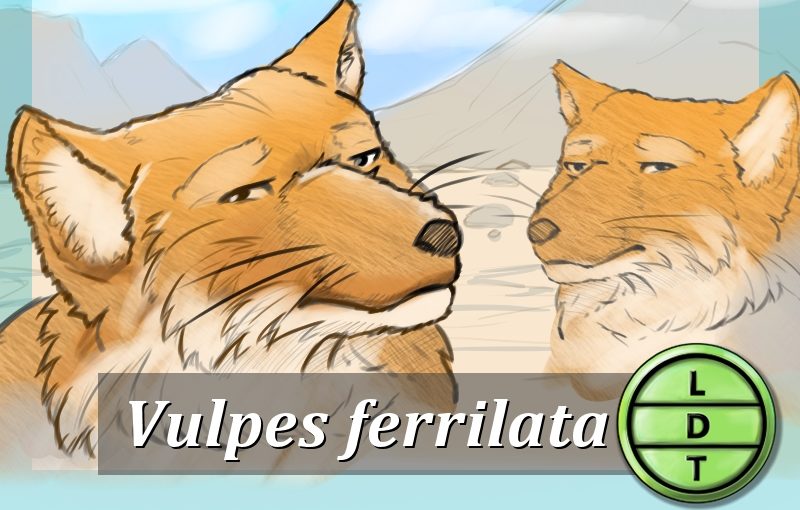“And today we are talking about an animal that David Attenborough once called ‘the most wonderful looking fox’ and also ‘bizzare with a curious body shape.’ I guess a fox can be two things but more on that later…”
The Ethiopian highlands are often called the roof of Africa, but The Tibetan Plateau is called the roof of the world. The land here is tens of thousands of feet above sea level and it’s surrounded by some of the tallest mountains on the planet. Living and surviving in a place that regularly drops to -40 degrees Fahrenheit can be a challenge to the animals that live here. One unique mammal has found a way to team up with unsuspecting allies. Sometimes, a reluctant and one-sided partnership, is the best way a cunning fox can secure a meal in Life, Death, and Taxonomy.
Measure Up
Length
- 60 to 70 centimetres (24 to 28 in)
- 65 cm (26.5 inches)
- How many foxes go into the horn of a domestic yak (48 to 99 cm (19 to 39 in))?
- Hint: Because of a lack or arable land, many of tibet’s farmers raise animals and cattle, including domestic cattle, with the binomial name, Bos grunniens.
- Answer: A little more than one to 1.5.
Weight
- 4 to 5.5 kilograms (8.8 to 12.1 lb)
- 10.5 pounds
- How many foxes go into the weight of the worlds largest rice dumpling (1,316 kg (2,901 lb 4 oz)).
- Hint: The dumpling was made in Yunlin, Taiwan by the Yunlin County Government in 2005.
- Answer: 276 foxes
Major Fact
The Tibeten Fox engages in what’s called commensalism.
- Commensalism is a form of interspecies cooperation where one species is benefited and the other is not benefited or harmed.
- Other forms of interspecies interaction can include symbiosis, which is when both scieces are benefited, and parasitism, which is when only one species benefits.
- One of the clearest examples of commensalism is seen in remora fish that hang out around larger fish and eat scraps.
- However, dogs and canines also routinely engage in commensalism.
- The Tibeten fox lives in areas of asia like the himalayas and the tibetan plateau in high elevation.
- Up there, it gets extremely cold and the ground conceals a layer of permafrost.
- Permafrost is a layer of dirt and rock that remains permanently frozen.
- It’s usually just beneath an “active layer” of soil that’s not always frozen.
- In the Tibeten fox’s range, the best thing on the menu are pikas.
- Unfortunately for the fox, they like to burrow in the permafrost, which is difficult for the fox to dig through.
- So, they follow around brown bears. Bears are strong enough to root dig through the permafrost, sending the pikas running for the hills, where the fox catches them.
Because canines like to comensalate, it’s possible that that behavior led to us having pupperions in our houses today.
- Natural historians believe that dog domestication has lasted longer than agriculture.
- Fossils seem to suggest that dogs would follow human hunters in the same way the fox follows the bear, hoping to snag a meal.
- Dangerous dogs were killed by humans, and friendly ones were rewarded.
- Over time, dogs and people cooperated more and more until they were fully domesticated.
Outro
Joe: Hey, LDT listeners! Thanks for listening to another season of interesting animal info. We forgot to say our thank yous last episode! So here they are, at the beginning of our tenth season.
Carlos: As always, we want to thank Brian, who creates all of the art for each episode. If you haven’t seen it, check it out at ldtaxonomy.com and take a look at some of Brian’s other work at xnamaru on Twitter and Instagram.
Joe: We also want to thank frequent contributors to the show like Pooles and the Barrel-chested woodcarver Tom.
Carlos: And don’t forget the expert dog bark impersonator Allora.
Joe: Finally, thank you to my girlfriend Johanna, who created some amazing LDT cover art, which you can see when you go and subscribe on your favorite podcast app.
Carlos: We also want to thank my wife, Bibby, who puts up with us recording in the closet and comes up with all the good animal nicknames.
Joe: As we grow nearer to our 100th episode, let us know what we should do to celebrate. Also, stay tuned for a special announcement.
We’re coming up on election season and it’s your chance to get out there and let your voice be heard! Yes, you have an opportunity to cast your vote for your local and federal representatives, but more importantly, you’ll also have a chance to vote for the best segment of Life, Death, and Taxonomy. Voting will start December 3rd on Twitter and Facebook! If you don’t follow us, we are ldtaxonomy, everywhere. Get out there, and make your vote count towards the most important decision of 2019!

